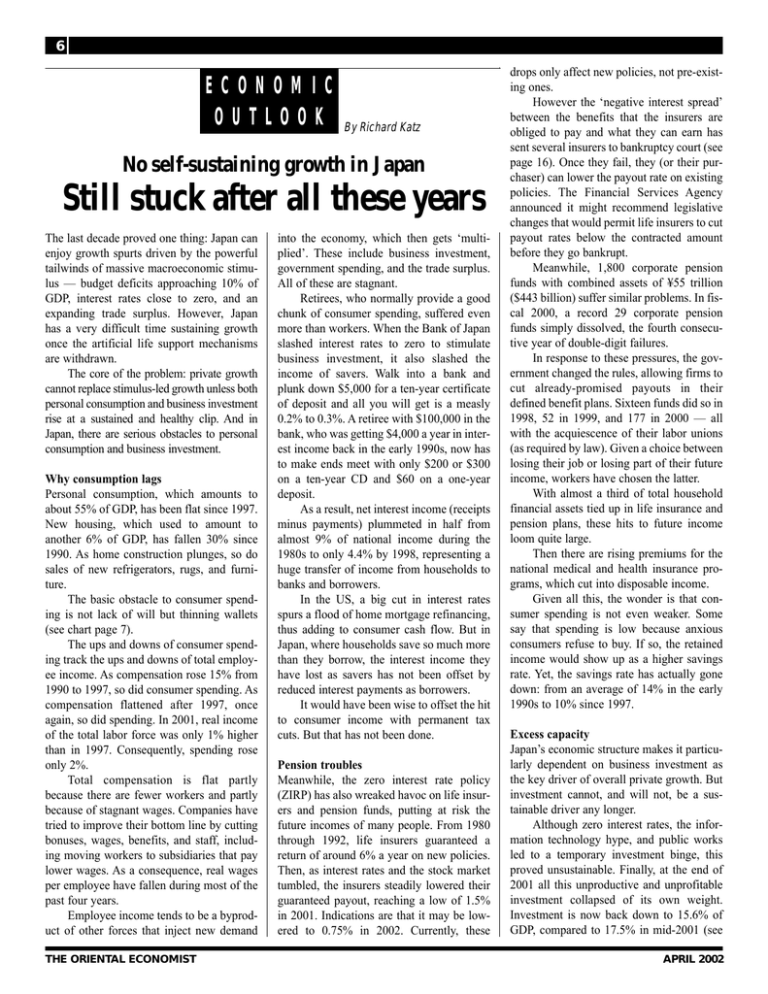6
advertisement

6 ECONOMIC OUTLOOK By Richard Katz No self-sustaining growth in Japan Still stuck after all these years The last decade proved one thing: Japan can enjoy growth spurts driven by the powerful tailwinds of massive macroeconomic stimulus — budget deficits approaching 10% of GDP, interest rates close to zero, and an expanding trade surplus. However, Japan has a very difficult time sustaining growth once the artificial life support mechanisms are withdrawn. The core of the problem: private growth cannot replace stimulus-led growth unless both personal consumption and business investment rise at a sustained and healthy clip. And in Japan, there are serious obstacles to personal consumption and business investment. Why consumption lags Personal consumption, which amounts to about 55% of GDP, has been flat since 1997. New housing, which used to amount to another 6% of GDP, has fallen 30% since 1990. As home construction plunges, so do sales of new refrigerators, rugs, and furniture. The basic obstacle to consumer spending is not lack of will but thinning wallets (see chart page 7). The ups and downs of consumer spending track the ups and downs of total employee income. As compensation rose 15% from 1990 to 1997, so did consumer spending. As compensation flattened after 1997, once again, so did spending. In 2001, real income of the total labor force was only 1% higher than in 1997. Consequently, spending rose only 2%. Total compensation is flat partly because there are fewer workers and partly because of stagnant wages. Companies have tried to improve their bottom line by cutting bonuses, wages, benefits, and staff, including moving workers to subsidiaries that pay lower wages. As a consequence, real wages per employee have fallen during most of the past four years. Employee income tends to be a byproduct of other forces that inject new demand THE ORIENTAL ECONOMIST into the economy, which then gets ‘multiplied’. These include business investment, government spending, and the trade surplus. All of these are stagnant. Retirees, who normally provide a good chunk of consumer spending, suffered even more than workers. When the Bank of Japan slashed interest rates to zero to stimulate business investment, it also slashed the income of savers. Walk into a bank and plunk down $5,000 for a ten-year certificate of deposit and all you will get is a measly 0.2% to 0.3%. A retiree with $100,000 in the bank, who was getting $4,000 a year in interest income back in the early 1990s, now has to make ends meet with only $200 or $300 on a ten-year CD and $60 on a one-year deposit. As a result, net interest income (receipts minus payments) plummeted in half from almost 9% of national income during the 1980s to only 4.4% by 1998, representing a huge transfer of income from households to banks and borrowers. In the US, a big cut in interest rates spurs a flood of home mortgage refinancing, thus adding to consumer cash flow. But in Japan, where households save so much more than they borrow, the interest income they have lost as savers has not been offset by reduced interest payments as borrowers. It would have been wise to offset the hit to consumer income with permanent tax cuts. But that has not been done. Pension troubles Meanwhile, the zero interest rate policy (ZIRP) has also wreaked havoc on life insurers and pension funds, putting at risk the future incomes of many people. From 1980 through 1992, life insurers guaranteed a return of around 6% a year on new policies. Then, as interest rates and the stock market tumbled, the insurers steadily lowered their guaranteed payout, reaching a low of 1.5% in 2001. Indications are that it may be lowered to 0.75% in 2002. Currently, these drops only affect new policies, not pre-existing ones. However the ‘negative interest spread’ between the benefits that the insurers are obliged to pay and what they can earn has sent several insurers to bankruptcy court (see page 16). Once they fail, they (or their purchaser) can lower the payout rate on existing policies. The Financial Services Agency announced it might recommend legislative changes that would permit life insurers to cut payout rates below the contracted amount before they go bankrupt. Meanwhile, 1,800 corporate pension funds with combined assets of ¥55 trillion ($443 billion) suffer similar problems. In fiscal 2000, a record 29 corporate pension funds simply dissolved, the fourth consecutive year of double-digit failures. In response to these pressures, the government changed the rules, allowing firms to cut already-promised payouts in their defined benefit plans. Sixteen funds did so in 1998, 52 in 1999, and 177 in 2000 — all with the acquiescence of their labor unions (as required by law). Given a choice between losing their job or losing part of their future income, workers have chosen the latter. With almost a third of total household financial assets tied up in life insurance and pension plans, these hits to future income loom quite large. Then there are rising premiums for the national medical and health insurance programs, which cut into disposable income. Given all this, the wonder is that consumer spending is not even weaker. Some say that spending is low because anxious consumers refuse to buy. If so, the retained income would show up as a higher savings rate. Yet, the savings rate has actually gone down: from an average of 14% in the early 1990s to 10% since 1997. Excess capacity Japan’s economic structure makes it particularly dependent on business investment as the key driver of overall private growth. But investment cannot, and will not, be a sustainable driver any longer. Although zero interest rates, the information technology hype, and public works led to a temporary investment binge, this proved unsustainable. Finally, at the end of 2001 all this unproductive and unprofitable investment collapsed of its own weight. Investment is now back down to 15.6% of GDP, compared to 17.5% in mid-2001 (see APRIL 2002 7 APRIL 2002 in 1997. But protected sectors are still adding to the excess. According to Morgan Stanley, 2.7 square million meters of new office space is coming on line in 2003, causing vacancy rates to exceed 8% for the next two years, worse than during the 1994 recession. The consequence is continuing downward pressure on rents and property prices. Not surprisingly, some LDP politicians have called on the Bank of Japan to print money and buy property so as to fight asset deflation – and essentially, validate these bad investments. Compound problem Japan now suffers the worst of both worlds. Its investment is not growing fast enough to fuel self-sustaining recovery — and never will. And yet, investment is still so high that firms continue adding to capacity, making the excess even greater. Net investment — the amount above and beyond that needed simply to replace worn out buildings and machines — added up to 5% of GDP in the 2001. While that is down from 10% of GDP a decade earlier, it’s still too much to be profitable or sustainable. An economy with a growth rate of only 1-2%, not to mention a falling labor force, cannot profitably use all the new capacity created via investment rates of 15-17% of GDP. This rate is “more appropriate for an economy whose trend growth is 4% per year than 1%,” in the words of the OECD. Sooner or later, investment will fall to something more like 13-14% of GDP, according to Morgan Stanley’s Robert Feldman. Japan needs to shift to consumer-led demand, which will entail enormous structural reforms. That will take time. Investment, % of real GDP Investment rate falls, but still too high 20% 20% 18% 18% 16% 16% 14% 14% 12% 12% 85 86 87 88 89 90 91 92 93 94 95 96 97 98 99 00 01 Source: Cabinet Office at http://www.esri.cao.go.jp/en/sna/menu.html Consumption is flat because income is flat Index, 1997 = 100 (in real 1995 yen) chart page 7). It will fall substantially further this year. All of Tokyo’s economic strategies have been based on the premise that fiscal and monetary stimulus would lead to a revival of business investment, which, in turn, would stimulate new production, hiring, and consumer spending. That’s how it works in healthy economies. But who exactly is supposed to do all this investment? The economy is plagued with excess capacity. Adding still more is the quick route to even smaller profits and even more nonperforming loans. Automakers can build 14-15 million vehicles a year. Yet, not since 1993 have they sold as many as 11 million units, domestic sales and exports combined. These days, sales are closer to 10 million. Factor in that two-thirds of the auto industry’s market is overseas, and that this market is increasingly being reached via overseas production instead of exports. In fact, exports in the year 2000 (4.4 million) were down about a third from the 1985 peak (6.7 million). The industry will never sell anything close to 15 million units. And yet, only recently have auto makers begun reducing capacity. Then there is integrated steel. While it can produce over 110 million tons a year, not once in the last two decades has it sold more than 80 million tons. As of 2001, capacity was down a mere 5% from the 1996 peak. How about retail? Since 1997, store sales at large-scale stores have been falling at a 3-4% annual clip. Yet, propelled by the drive for market share and protected by their banks against failure, these retailers kept expanding floor space at a 5-6% rate since 1993. Eventually, even in Japan, the law of gravity prevails. The last couple of years have seen multi-billion dollar bankruptcies and near-bankruptcies of such industry giants as Sogo, Daiei, Seiyo, and Mycal. Perhaps that is why in the year 2000 the pace of expansion finally slowed to 1%. Overall, according to estimates by Japan’s Cabinet Office, 13-15% of Japan’s total capital stock (factories, machinery, stores, office buildings, public infrastructure) is excess. For companies to work off all their excess, they’d have stop every yen of investment for eight months. In some sectors that are more sensitive to market pressures, capacity reduction has already begun. Manufacturers have already reduced capacity by 5% from the high point 105 105 Personal Consumption Personal Consumption 100 100 95 95 Employee Employee Compensation Compensation 90 90 85 85 80 80 90 91 92 93 94 95 96 97 98 99 00 01 Source: Cabinet Office at http://www.esri.cao.go.jp/en/sna/menu.html THE ORIENTAL ECONOMIST



